ILC's treatment for
Cervical Disc Herniation
Having been adopted in over 54 countries globally,
the "Cellgel Method" for treating intervertebral discs
is now available in Japan
For those who have been told it was impossible to operate,
For those who have had recurrence of pain post-surgery,
A low-risk, outpatient treatment is now an option for you.
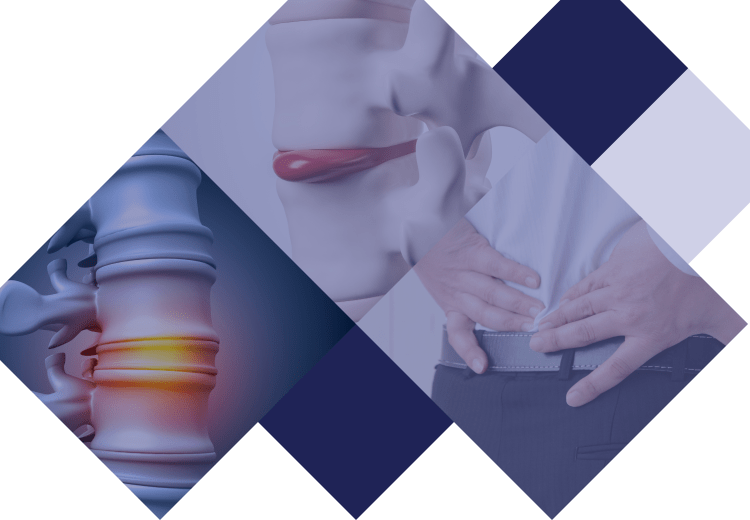
Contents
 Table of Contents
Table of Contents
This page provides information on the main symptoms and causes of cervical disc herniation and our treatment procedures. The information includes the methods of treatment, length of stay at the hospital, and information about health insurance coverage. We use the Cellgel method, which is one of the most advanced methods in the world, and the characteristics of this method are also described in detail.
Please read this page especially if you have been told that you cannot be cured without surgery, if you have had surgery in the past but have seen no improvement so far, or if your condition did improve after surgery, but the symptoms have since recurred.
What is cervical disc herniation?
The spine is constituted of interconnected vertebrae, with from the top down, the cervical, thoracic, and lumbar vertebrae. The intervertebral discs are located between the vertebrae.
The intervertebral discs have a gelatinous nucleus pulposus at their center and a collagen-rich annulus fibrosus surrounding the nucleus pulposus. The intervertebral disc is made up of these 2 tissues, the nucleus pulposus and the annulus fibrosus. A herniated disc is a condition in which the nucleus pulposus protrudes outward due to a crack in the annulus fibrosus.
When the nucleus pulposus protrudes from the disc that connects the 7 cervical vertebrae and compresses the nerve, it is called a cervical disc herniation.
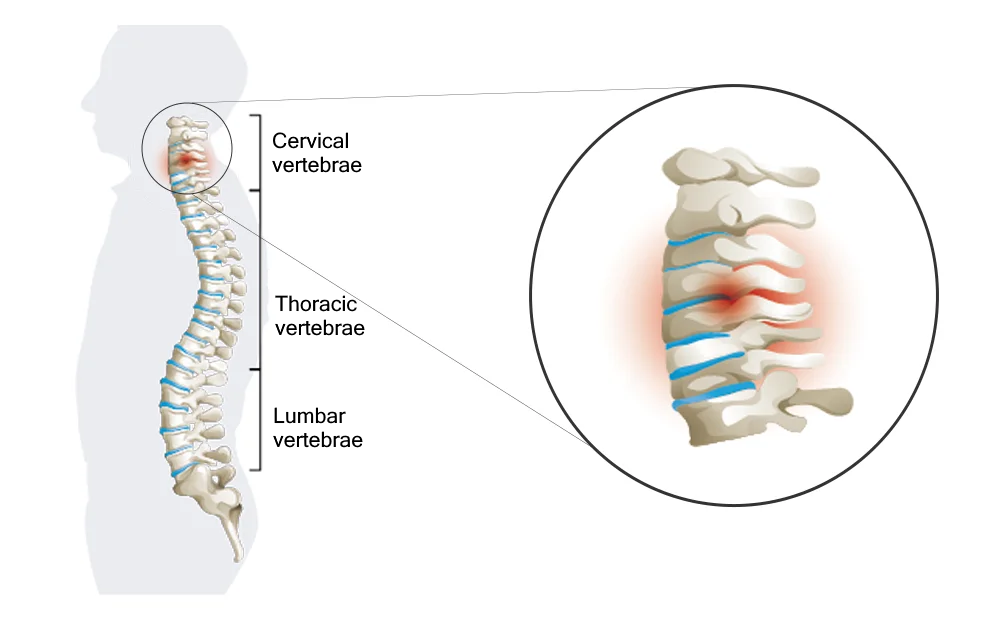
Main symptoms of cervical disc herniation

Symptoms of a cervical disc herniation may vary widely. Main symptoms include pain in the neck and shoulder area, stiffness in the shoulders, numbness and swelling in the hands, heavy arms, and muscle weakness. Writing may become difficult, chopsticks may be hard to hold while eating, and buttons may be hard to button when getting dressed.
As the disease progresses, symptoms such as headaches, pain behind the eyes, eyestrain, tinnitus, dizziness, and lightheadedness may occur, and as the condition worsens, symptoms in the lower body (such as difficulty walking and leg cramps) may also develop.
What causes cervical disc herniation?
The main cause is aging of the intervertebral discs due to the strain of age and daily life. The intervertebral discs in the cervical spine are under constant pressure and are considered to age the fastest. This makes them more prone to herniated discs.
Other factors include desk work with poor posture, sports that place stress on the neck (gymnastics, judo, wrestling, skiing, snowboarding, etc.), and accidental falls. Cervical disc herniation can occur with neck-straining activities such as lifting heavy loads.
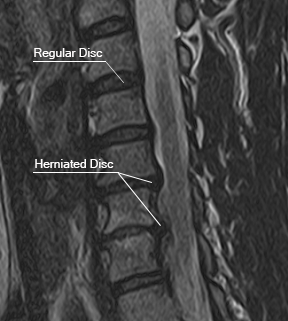
Why is the recurrence rate so high?
In conventional surgery, a herniated disc is removed through an incision made in the front of the neck under general anesthesia, and a bone taken from one's own pelvis or an artificial bone is placed in the open space to firmly secure the cervical vertebrae. This eliminates the disability of the herniation, but after the surgery, the discs immediately above and below develop excessive stress, and as a result new herniated discs may form within 10 years after the surgery.
With the Cellgel method used at our clinic, we inject a drug that replenishes the cracks in the disc, then aggregates into a gel that repairs the cracks and preserves the disc, curing the fundamental cause in the process.
Conventional Surgery
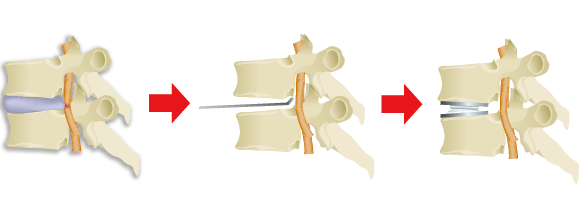
Under fluoroscopic image, the herniated disc is surgically extracted, a portion of the cervical vertebrae of the cervical spine is removed, and a disc replacement called a "cage" is put in place.
Cellgel Method
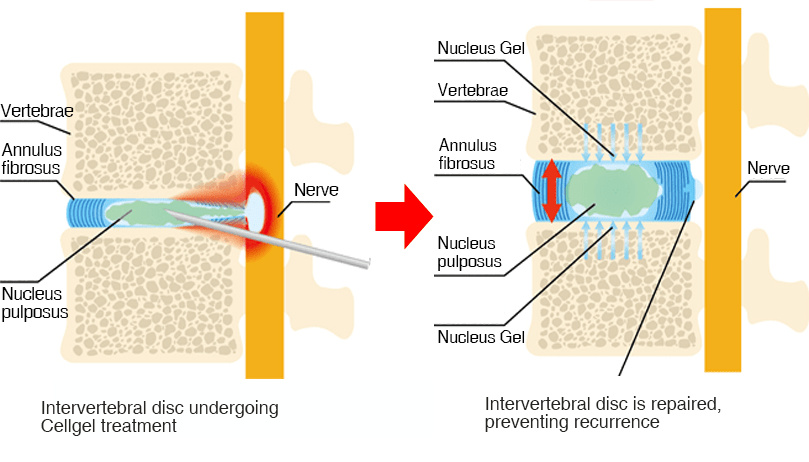
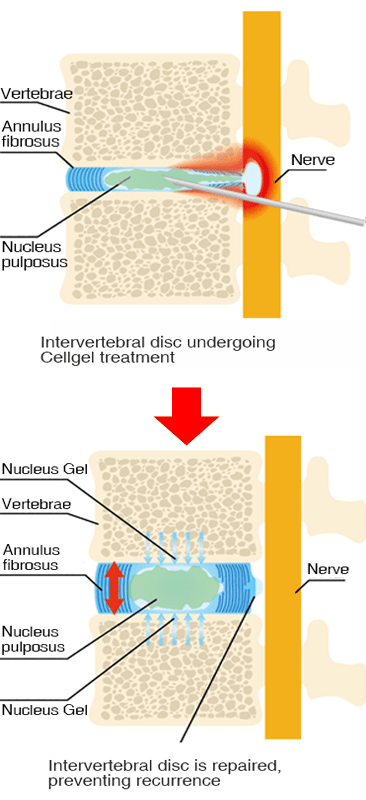
Since many of our patients come from far away,
we are happy to give free consultations to see which treatment is best for you
We'll diagnose your MRI images for free!
Treatment at ILC
There are four main treatments at our clinic.
As mentioned above, the root cause of each cervical pain disease is "inflammation and deformation due to aging of the intervertebral discs." Although the four treatment methods have different features and advantages, we would like to first introduce the "Cellgel method," which is the only one capable of intervertebral disc repair.
The Cellgel Method
About Cellgel
The Cellgel method is an advanced treatment for pain that has been implemented in more than 54 countries worldwide, predominantly in Europe.
As with other treatments, it does not decrease the disc volume, and since the drug remains in the disc as a gel-like implant after treatment, the disc can be preserved. Recent studies have also shown that the volume of the disc increases after treatment.*1
It is also thought that by repairing the disc and preventing leakage of the Nucleus Pulposus, the disc itself will restore its normal function with its own regenerative ability (*2).
*1 Source: European Journal of Radiology 109 (2018) 101–107 , Efficiency of an ethyl alcohol gel in symptomatic disc hernation
*2 Source: International Journal of Spine Surgery Vol. 15 Appendix 1 from regenerative treatment of disc degeneration
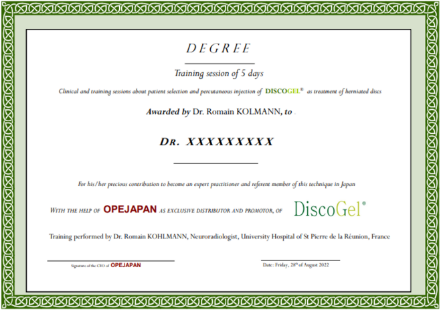
"Results were satisfactory in 89.5% patients, with no adverse events recorded during the procedure or after. The use of RGE shows promising results and might be a feasible and safe alternative in the treatment of cervical disk hernias."
- Dr. J. Theron, one of the world's leading experts in the treatment of Celgel method, from his research article "Percutaneous treatment of cervical disk hernias using gelified ethanol"
Merits of Cellgel
- Possibility to repair intervertebral discs where unable to using surgical or laser treatment
- As the disc is repaired, the disc itself regains its original normal function through its own regenerative ability
- The Cellgel method uses local anesthesia over general anesthesia used in conventional surgery, making it less burdensome on the body
- Treatment is done with a thin needle, so the wound is minimal and recovery is rapid
- Treatment is very short, allowing for outpatient day treatment
- Safe, modern treatment proven in more than 54 countries around the world
Flow Cellgel Treatment Process
-
01 Examination

MRI and X-rays will be taken, followed by a doctor's diagnosis.
If the diagnosis proves the Cellgel method suitable, treatment can begin that same afternoon. -
02 Before

TreatmentAfter entering the treatment room and administering local anesthesia to the neck, a needle is inserted into the intervertebral disc identified in the examination.
A contrast scan is performed to confirm the location of the damaged disc. -
03 Treatment
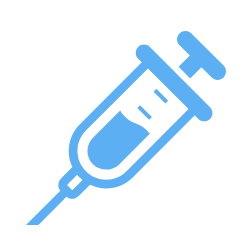
The Cellgel drug is administered to the damaged area while confirming the location of the disc with a fluoroscopy device.
Once the drug has been absorbed, the needle is removed and the bleeding is stopped.
-
04 Returning

HomeAfter the treatment, the patient recuperates in a private room for about an hour, and then allowed to go home after the post-treatment examination.
*Resting time depends on the patient's symptoms and condition.
Price Cost of treatment for Cervical Disc Herniations
| Treatment | 1 disc | 2 discs | 3 discs | 4 discs | 5 discs |
|---|---|---|---|---|---|
| Cellgel Method | 1,760,000 JPY | 2,090,000 JPY | 2,420,000 JPY | 2,750,000 JPY | 3,080,000 JPY |
| PODD Method | 770,000 JPY | 990,000 JPY | 1,210,000 JPY | 1,430,000 JPY | 1,650,000 JPY |
Swipe left/righ
* The cost of treatment is indicated including taxes.
*If treatment is performed at our clinic, all examination/diagnosis costs and test costs such as MRI are included in the above costs.
*This treatment method is not covered by Japanese health insurance, so you will have to pay for the entire treatment yourself.
*Payment by credit card (VISA, MasterCard, JCB, American Express, Diners, Discover) is also possible.
*If you would like rehabilitation (low back pain specialized rehabilitation), it is also possible to pay by bank transfer.
*If you live and work in Japan, you can receive a tax refund by filing your final medical expense return.
FAQ Questions about cervical disc herniation and treatment
-
QWhat is the difference in recurrence rate between the Cellgel method and surgery?
-
AWith surgery, an incision is made in the front of the neck under general anesthesia, the herniated disc is removed, and a bone taken from the patient's pelvis, or an artificial bone is inserted into the open space to properly anchor the cervical vertebrae. After the surgery, the upper and lower discs are put under extreme stress, and a new herniated disc may form within 10 years after the surgery, so the recurrence rate is known to be a problem.
In contrast, the Cellgel procedure performed at our clinic injects a drug into the damaged disc and preserves the disc. Not only are symptoms improved, but the recurrence rate is also extremely low.
-
QHow are the disc levels to be treated determined?
-
AThe doctor will spend about 30 minutes interviewing the patient while looking at the MRI and x-ray images to establish the cause of the condition, determine the treatment area, and explain the corresponding treatment method to the patient. MRI images can confirm changes in shape, the pressure applied on the nerves, the presence or absence of damage and inflammation on the discs, nerves, ligaments, and joints, which are highly related to pain factors. The use of x-ray images is mainly to confirm the condition of the bones.
-
QMy pain may temporarily worsen after treatment. How long will it last?
-
AThe reason for the pain is that spinal ligaments that have been compressed are stretched; the pain lasts for about two weeks and then subsides.
-
QWhat level of exercise can I perform after treatment?
-
AGeneral recreational exercise and sports can be done without any problem. For professional athletes, the possibility of new disc damage is high and should be discussed in consultation with a doctor.
-
QWhat precautions should I take after treatment?
-
ADuring the first few days after the surgery, the patient should rest and avoid any activity that puts stress on the neck or strenuous exercise. At one week after the surgery, you will be able to perform daily tasks, and at two weeks, you will be able to do light exercises. Weight training is allowed after 3 months.
-
QIs the procedure covered by the Japanese national health insurance?
-
ANo, it is not covered by insurance. If you have life insurance, you may be eligible. Please feel free to contact our staff.
-
QHow long after the treatment will I be able to walk?
-
AYou can walk home about one hour after the treatment for one-day treatment.
-
QHow many visits will I need before treatment?
-
ATwo visits are required: once for MRI imaging at a clinic affiliated with our clinic and once on the day of treatment.
-
QIs flying on a plane possible after the treatment?
-
AIf there are no problems after the surgery, you may fly. If there is any remanent pain after the surgery, depending on the doctor's assesment, flying may not be recommended.
-
QHow is cervical disc herniation diagnosed?
-
AWe make a comprehensive diagnosis by looking at the current symptoms, the course of the disease to date, and the results of a physical examination, followed by a thorough examination using MRI and x-rays.
An MRI scan is effective in visually confirming a herniated disc; it shows the location, size, shape, and nerve compression of the herniated disc, and confirms whether it is easily cured if left untreated naturally, and if so, what kind of treatment is appropriate.
MRI may not be able to detect small hernias depending on the performance of the MRI scanner and the method of imaging.
Even if a herniation is detected, there may be another cause of the numbness or pain.
It is possible to be told that you do not have a herniated disc, but actually have a small herniated disc, or to be told that you have a herniated disc, but actually have another disease.
Please consider having a medical examination first.
-
QHow long and how soon can I walk after herniated disc surgery?
-
AIt depends on the condition of the disease, but you will need to stay in the hospital for 10 to 14 days. After that, you can return home.
The Cellgel method and other treatment methods we offer are day treatment, so you can walk home about one hour after the surgery.
-
QDo I need rehabilitation after treatment with the Cellgel method?
-
ARehabilitation may improve the effectiveness of the treatment.
Resting after the treatment will cause motor function to decline, so we recommend moderate stretching and other exercises.
We also provide exercise instruction on the day of treatment, so please feel free to consult with us about postoperative exercise.
-
QIs a herniated cervical disc a dangerous disease?
-
ASome people have more severe symptoms than others, and as the herniation progresses, the limbs may become paralyzed, excretion may become difficult, and the whole body may be severely affected.
The most important thing is to first diagnose the disease and find appropriate treatment.
-
QWhat happens if a cervical disc herniation is left untreated?
-
AA cervical disc herniation is a condition in which symptoms disappear and may heal spontaneously.
A herniated disc will not repair or regenerate, but it may shrink or disappear.
Before considering surgical treatment, we try to monitor changes in symptoms and suggest the least burdensome treatment.
-
QOnce a herniation has been treated, can it ever recur?
-
AThe Cellgel treatment repairs the damage to the annulus fibrosus of the intervertebral discs that caused the herniation. Therefore, there have been no reports of recurrence of herniation in the treated disc so far.
-
QIs it possible to perform the Cellgel procedure after a surgical procedure?
-
AYes, it is possible, but since we treat the disc itself, it can only be performed to prevent the development of new herniations in the discs above and below the surgically fixed area. We will first perform an examination and consultation to diagnose the best treatment.
-
QIf I am diagnosed with a herniated cervical disc, should I exercise less?
-
AModerate exercise is necessary unless the pain is so severe that you cannot exercise. Failure to exercise may cause the muscles in the body to weaken and the pain to increase.
Learning how to exercise properly may relieve symptoms. Our clinic is working with a rehabilitation facility to improve the root cause of your pain.
-
QWhat should I be careful about after surgery for a herniated cervical disc?
-
AAfter our cervical disc herniation treatment, you can go home the same day.
We also recommend that you refrain from strenuous exercise and moderate stretching for about one month.
We aim to achieve 100% effectiveness of treatment while incorporating the latest technology, so we spend at least 30 minutes with each patient to carefully and meticulously examine the patient's concerns in order to make a proper diagnosis and propose the most suitable treatment methods.
We are certain to find a way to alleviate or eliminate the pain and numbness you are experiencing, so please do not give up and give us a call instead!
- Tadaaki Minowa, Clinic Director



